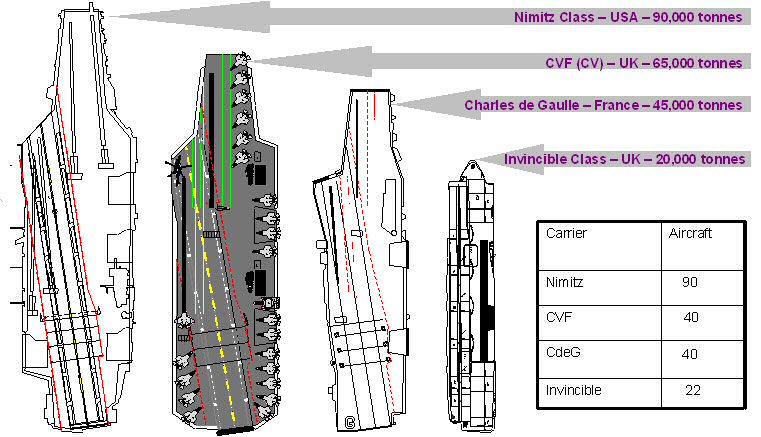 Above, a size and capacity comparison (CLICK on image to enlarge).
Above, a size and capacity comparison (CLICK on image to enlarge).
The story of the protracted and tortuous design, development and construction of the Royal Navy’s future aircraft carriers, HMS Queen Elizabeth and HMS Prince of Wales is sadly a familiar tale. British Gazette readers will recall the sorry tale of the ill-fated CVA-01 and CVA-02 carriers that were planned to replace the Royal Navy’s last fleet carriers capable of operating conventional fixed wing aircraft, HMS Ark Royal and HMS Eagle. The story of CVA-01 and CVA-02 was a typically British one of imaginative and inventive design battling with an ever shrinking budget, inter-service in-fighting (for their share of an ever shrinking cake) and political indecision on the part of government. In the end the Royal Navy’s conventional aircraft carriers were replaced by the small 23,000 ton “Harrier carriers” of the Invincible class. It is interesting to note that these ships were ordered as “through deck cruisers” to avoid annoying Labour Party MPs and members.
As designed the CVF is to operate an air-wing of 40 aircraft. Their principal asset is to be the promising Lockheed Martin F-35 Lightning II “Joint Strike Fighter.” The original plan was for the Royal Navy to operate the F-35B “jump jet” version that is to be operated by the USMC. Following the coming to power of the coalition the politicians were advised that cancellation of the carriers were going to be more expensive than completing them. Clearly the shipbuilders had used some common sense and had insisted on severe penalty clauses to prevent cancellation. The politicians then ordered a redesign to have the carriers completed as conventional CATOBAR (Catapult Assisted Take Off Barrier Arrested Recovery) and have the RN operate the F-35C that is to be operated by the USN.
However, on 10th May 2012 Defence Secretary Philip Hammond announced in Parliament that the government had decided to revert to its predecessor’s plans to purchase the F-35B rather than the F-35C, and to abandon the completion of Prince of Wales to a CATOBAR configuration. The reason given was that, “conversion to ‘cats and traps’ will cost about double what was originally estimated – and would not be delivered until 2023 at the earliest.
The concentration by the politicians and the media on whether the F-35B or F-35C is to operated completely misses the most important point. British Gazette readers will of course not be surprised at this as they know only too well that Mr Hammond, Mr Cameron, Mr Clegg and Mr Miliband have absolutely no experience whatsoever of service in the armed forces.
These politicians are ignoring one of the most important aspects of operating an aircraft carrier: the absolute need for effective airborne early warning and control. Effective AEW requires ALTITUDE. The Fairey Gannet operated by the Fleet Air Arm between 1953 and 1978 had a service ceiling (that is how high the aircraft can fly, Mr Miliband) of 25,000 feet (Mr Miliband, you will have to convert this figure into metres yourself). Following the commissioning of HMS Invincible, the essential AEW role was carried out by a small number of specially adapted Westland Sea King helicopters. Unfortunately, the Sea King has a service ceiling of a mere 14,700 feet. Compare this with the service ceiling of 34,700 feet of the Northrop Grumman E-2 Hawkeye, the AEW aircraft operated by the USN from its Nimitz class carriers. The Boeing V-22 Osprey, the troubled tilt-rotor aircraft has been suggested as a possible airframe for the AEW. The Osprey’s service ceiling is 25,000 feet of the old Gannet. However, times and threats have changed since 1978.
Given the budgetary restrictions the Royal Navy has to work within it is likely that the Merlin helicopter will be adapted to the role. The Merlin’s service ceiling is a mere 15,000 feet and is completely inadequate against a sophisticated foe.
What then does this mean?
It means that the Royal Navy WILL NOT be able to independently operate these ships as fleet aircraft carriers. These ships could however be valuable and useful ships operating in a support role to a USN task force centred around a Wasp class assault carrier. If these ships are commissioned into the Royal Navy then it is very unlikely they will embark more than 12 F-35B fighters (a single squadron). This will allow space for embarking a considerable number of helicopters. Given the projected areas of operation – off the coasts of third world countries – no more than four Merlin helicopters would be needed for the AEW role with a probable zero need for ASW role helicopters. The remaining helicopters could be the Westland AW159 Lynx Wildcat (previously called the Future Lynx) – an improved version of the Westland Super Lynx military helicopter. The AW159 will serve in the battlefield utility, search and rescue and anti-surface warfare roles. The helicopter has been ordered for the British Army and Royal Navy. It is to enter service with the Army in 2014 and with the RN in 2015.
Sadly however, a likely outcome will be the sale of one or both of these ships to India – for less than they cost to build. This will satisfy the Treasury as although the ships will have cost more to build than India will have paid for them, their future operating costs – for the UK taxpayer – will be zero.
Speaking the Truth unto the Nation

Treason and Treasury are bedmates.